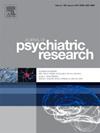加速深度间歇脉冲刺激强迫症:一项双盲、随机对照研究
IF 3.7
2区 医学
Q1 PSYCHIATRY
引用次数: 0
摘要
fda批准的强迫症治疗方案包括针对内侧前额皮质进行为期6周的20赫兹深经颅磁刺激(dTMS)。然而,针对同一区域的加速深度间歇θ波爆发刺激(d-iTBS)的效果尚未在随机对照试验中进行评估。本研究通过研究一种改进的、持续时间更短的d-iTBS方案来解决这一差距。方法干预包括连续两周每天5次,共50次d-iTBS。主要结果测量是耶鲁-布朗强迫症量表(Y-BOCS)和维度强迫症量表。采用重复测量方差分析分析临床评分的变化。结果在GroupxTime交互作用中,活性组和安慰剂组总强迫症状(OCS)的减少具有统计学意义。然而,当单独检查强迫和强迫时,也没有在特定的OCS维度上观察到这种影响。在x时间组相互作用中,抑郁和焦虑症状的减少没有达到统计学意义。在积极治疗组中,OCD发病年龄越早,总OCS的降低幅度越大。两两比较显示,从治疗前到治疗终点,从治疗前到两周随访,Y-BOCS总分的变化无统计学意义。然而,治疗终点与两周随访之间的评分下降趋势具有显著性(p = 0.051)。结论针对mPFC的加速d-iTBS可有效减轻强迫症症状;然而,其治疗效果可能在治疗完成后几周变得更加明显。本试验已在ClinicalTrials.gov注册(NCT06177470)。本文章由计算机程序翻译,如有差异,请以英文原文为准。
Accelerated deep intermittent theta-burst stimulation obsessive-compulsive disorder: A double-blind, randomized, controlled study
Aim
The FDA-approved protocol for OCD involves six weeks of 20 Hz deep transcranial magnetic stimulation (dTMS) targeting the medial prefrontal cortex. However, the efficacy of accelerated deep intermittent theta burst stimulation (d-iTBS) targeting the same region has not yet been evaluated in randomized controlled trials. This study addresses this gap by investigating a modified, shorter-duration d-iTBS protocol.
Methods
The intervention consisted of five daily sessions over two consecutive weeks, totaling 50 d-iTBS sessions. The primary outcome measures were the Yale-Brown Obsessive Compulsive Scale (Y-BOCS) and Dimensional Obsessive-Compulsive Scale. Changes in clinical scores were analyzed using repeated measures ANOVA.
Results
The reduction in total obsessive-compulsive symptoms (OCS) exhibited a statistically significant difference between the active and placebo groups for the GroupxTime interaction. However, this effect was not observed when examining obsessions and compulsions separately, nor across specific OCS dimensions. Reductions in depressive and anxiety symptoms did not reach statistical significance for the Group × Time interaction. Within the active treatment group, an earlier age at OCD onset was correlated with a greater reduction in total OCS. Pairwise comparisons revealed that changes in total Y-BOCS scores from pre-treatment to the treatment endpoint and from pre-treatment to two-week follow-up were not statistically significant. Nevertheless, the reduction in scores between the treatment endpoint and two-week follow-up showed a trend toward significance (p = 0.051).
Conclusion
Accelerated d-iTBS targeting the mPFC appears to be effective in reducing OCD symptoms; however, its therapeutic effects may become more apparent several weeks after the completion of treatment.
The present trial is registered with ClinicalTrials.gov (NCT06177470).
求助全文
通过发布文献求助,成功后即可免费获取论文全文。
去求助
来源期刊

Journal of psychiatric research
医学-精神病学
CiteScore
7.30
自引率
2.10%
发文量
622
审稿时长
130 days
期刊介绍:
Founded in 1961 to report on the latest work in psychiatry and cognate disciplines, the Journal of Psychiatric Research is dedicated to innovative and timely studies of four important areas of research:
(1) clinical studies of all disciplines relating to psychiatric illness, as well as normal human behaviour, including biochemical, physiological, genetic, environmental, social, psychological and epidemiological factors;
(2) basic studies pertaining to psychiatry in such fields as neuropsychopharmacology, neuroendocrinology, electrophysiology, genetics, experimental psychology and epidemiology;
(3) the growing application of clinical laboratory techniques in psychiatry, including imagery and spectroscopy of the brain, molecular biology and computer sciences;
 求助内容:
求助内容: 应助结果提醒方式:
应助结果提醒方式:


